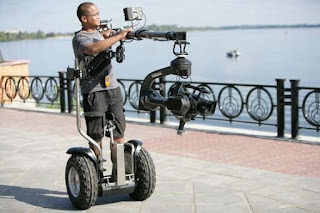Camera angles
The term camera angle means slightly different things to different people but it always refers to the way a shot is composed. Some people use it to include all camera shot types, others use it to specifically mean the angle between the camera and the subject. We will concentrate on the literal interpretation of camera angles, that is, the angle of the camera relative to the subject.
HIGH ANGLE
the camera looks down on someone. Not so extreme as a bird's eye view. The camera is elevated above the action using a crane to give a general overview. High angles make the object photographed seem smaller, and less significant (or scary). The object or character often gets swallowed up by their setting-they become part of a wider picture.
LOW ANGLE
These increise heigh (useful for short actors like Tom Cruise or James McAvoy) and give a sense of speeded motion. Low angles help give a sense of confusion to a viewer, of powerlessness within the action of a scene. The background of a low angle shot will tend to be just sky or ceiling, the lack of detail about the setting adding to the disorientation of the viewer. The added height of the object may make it inspire fear and insecurity in the viewer, who is psychologically dominated by the figure on the screen.
CANTED ANGLE
Sometimes the camera is tilted (i.e. is not places horizontal to floor level), to suggest imbalance,transition and instability (very popular in horror movies). This technique is used to suggest POINT OF-view (i.e. when the camera becomes the 'eyes' of one particular character, seeing what they see-a hand held camera is often used for this.
Camera movements Although camera movements are often implemented to add excitement to shots, their best use is when new informations revealed.At the beginning level, budding filmmakers sometimes tilt and pan without the proper motivation.
Pan movement
The camera moves from side to side.
During a pan, the camera is aimed sideways along a straight line. Note that the camera itself is no moving. It is often fixed on tripod, with the operator turning it either left or right. Panning is commonly utilized to capture images of moving objects like cars speeding or people walking; or to show sweeping like an ocean or cliff.
Tilt movement
The camera moves up or down on a crane.
Tilts refer to the up or down movement of the camera while the camera itself does not move. Tilts are often employed to reveal vertical objects like a building or a person.
Track movement
The camera follows a person or object.
Tracking is similar to doling. The main difference being that in dollies the camera is moved toward or away from the subject, whereas in a track shot, the camera is moved sideways, parallel to an object.
Crane movement
The camera moves up or down on a crane. The camera is mounted on a crane allowing the camera to move very high and then swoop back down to the ground. Sometimes the crane is mounted on a dolly so the camera can move along the ground and at the same time mov up into the air. Crane shots are often difficult to pull off but can be highly effective establishing shots.
Zoom
The camera zooms in our out. Zooms happen at the push of a button. Zoom in refers to seemingly "approaching" the subject, thus making it look bigger in the frame. Zoom out refers to seemingly "distancing" the subject, thus making it look smaller.

Reverse zoom
The lenses zooms in or out whilst the camera moves in the opposite direction, creates the impression that the background is constantly moving.
Hand-held movement
A skanky handheld effect. Filmmaking and video production technique in which a camera is held in the camera operator's hands as opposed to being mounted on a tripod or other base. Hand-held cameras are used because they are conveniently sized for travel and because they allow greater freedom on motion during filming.
SOUNDS it is part of the production process but mostly with the POST-PRODUCTION process.
Diegetic sound originating from a source in the scene,e.g. dialogue
Sound whose source is visible on the screen or whose source is implied to be present by the action of the film:
voices of characters
sounds made by objects in the story
music represented as coming from instruments in the story space
( source music)
Diegetic sound is any sound presented as originated from source within the film's world
Non-diegetic sound added in postproduction.Sound whose source is neither visible on the screen nor has been implied to be present in the action:
narrator's commentary
sound effects which is added for the dramatic effect
mood music
Non-diegetic sound is represented as coming from the a source outside story space.
Sound motif a sound of piece of music associated with a character,place or theme (like the JAWS)
The sound motifs condition the audience emotionally for the intervention, arrival, or actions of a particular character. The sound motifs can be very useful in the rough cut, where they help clarify the narrative functions of the characters and provide a sound association for those characters as we move through the story.
Ambient sound means the background sounds which are present in scene or location. Common ambient sounds include wind, water, birds, crowds,office noises, traffic, etc.
Providing audio continuity between shots.
Preventing an unnatural silence when no other sound is present.
Establishing or reinforcing the mood.
Sound mix the way in which the different sounds in a scene are mixed together.










No comments:
Post a Comment